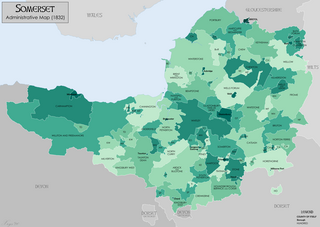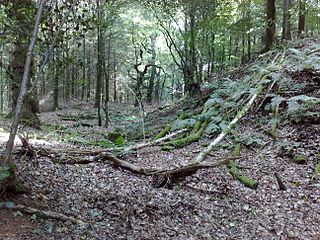Related Research Articles

Ceawlin was a King of Wessex. He may have been the son of Cynric of Wessex and the grandson of Cerdic of Wessex, whom the Anglo-Saxon Chronicle represents as the leader of the first group of Saxons to come to the land which later became Wessex. Ceawlin was active during the last years of the Anglo-Saxon expansion, with little of southern England remaining in the control of the native Britons by the time of his death.

Wessex was an Anglo-Saxon kingdom in the south of Great Britain, from 519 until England was unified by Æthelstan in 927.

Somerset is a county in South West England which borders Gloucestershire and Bristol to the north, Wiltshire to the east, Dorset to the south-east and Devon to the south-west. It is bounded to the north and west by the Severn Estuary and the Bristol Channel, its coastline facing southeastern Wales. Its traditional border with Gloucestershire is the River Avon. Somerset's county town is Taunton.

The Battle of Deorham is claimed as a decisive military encounter between the West Saxons and the Britons of the West Country in 577. The battle, which was a major victory for Wessex's forces led by Ceawlin and his son, Cuthwine, resulted in the capture of the Brythonic cities of Glevum (Gloucester), Corinium Dobunnorum (Cirencester), and Aquae Sulis (Bath). It also led to the permanent cultural and ethnic separation of Dumnonia from Wales.
Cynric was King of Wessex from 534 to 560. Everything known about him comes from the Anglo-Saxon Chronicle. There, he is stated to have been the son of Cerdic, who is considered the founder of the kingdom of Wessex. However, the 'Genealogical Regnal List', a copy of which prefaces some manuscripts of the Chronicle instead says that Cynric was the son of Cerdic's son, Creoda. Similarly, the paternal genealogy of Alfred the Great given in Asser's The Life of King Alfred, includes the name Creoda, while the account of the king's maternal ancestry in the same work calls Cynric son of Cerdic.
Geraint, known in Latin as Gerontius, was a King of Dumnonia who ruled in the early 8th century. During his reign, it is believed that Dumnonia came repeatedly into conflict with the neighbouring Anglo-Saxon Kingdom of Wessex. Geraint was the last recorded king of a unified Dumnonia, and was called King of the Welsh by the Anglo-Saxon Chronicle. Subsequent kings of Dumnonia reigned over an area that was eventually reduced to the limits of present-day Cornwall.

Dumnonia is the Latinised name for a Brythonic kingdom that existed in Sub-Roman Britain between the late 4th and late 8th centuries CE in the more westerly parts of present-day South West England. It was centred in the area of modern Devon, but also included modern Cornwall and part of Somerset, with its eastern boundary changing over time as the gradual westward expansion of the neighbouring Anglo-Saxon kingdom of Wessex encroached on its territory. The spelling Damnonia is sometimes encountered, but that spelling is also used for the land of the Damnonii, later part of the Kingdom of Strathclyde, in present-day southern Scotland. The form Domnonia also occurs and shares a linguistic relationship with the Breton region of Domnonée.

Wansdyke is a series of early medieval defensive linear earthworks in the West Country of England, consisting of a ditch and a running embankment from the ditch spoil, with the ditching facing north.

Somerton is a town and civil parish in the English county of Somerset. It gave its name to the county and was briefly, around the start of the 14th century, the county town, and around 900 was possibly the capital of Wessex. It has held a weekly market since the Middle Ages, and the main square with its market cross is today popular with visitors. Situated on the River Cary, approximately 8.8 miles (14.2 km) north-west of Yeovil, Somerton has its own town council serving a population of 4,697 as of 2011.

Somerset is a historic county in the south west of England. There is evidence of human occupation since prehistoric times with hand axes and flint points from the Palaeolithic and Mesolithic eras, and a range of burial mounds, hill forts and other artefacts dating from the Neolithic, Bronze and Iron Ages. The oldest dated human road work in Great Britain is the Sweet Track, constructed across the Somerset Levels with wooden planks in the 39th century BCE.

Anglo-Saxon England or Early Medieval England, existing from the 5th to the 11th centuries from the end of Roman Britain until the Norman conquest in 1066, consisted of various Anglo-Saxon kingdoms until 927, when it was united as the Kingdom of England by King Æthelstan. It became part of the short-lived North Sea Empire of Cnut the Great, a personal union between England, Denmark and Norway in the 11th century.

West Camel is a village and civil parish in south Somerset, England, about 7 miles (11.3 km) north of the town of Yeovil. It lies either side of the River Cam, just south of the A303, and has a population of 459. The parish includes the hamlet of Urgashay. Neighbouring villages include Queen Camel, and Bridgehampton.

The Battle of Peonnum was fought about AD 660 between the West Saxons under Cenwalh and the Britons of what is now Somerset in England. It was a decisive victory for the Saxons, who gained control of Somerset as far west as the River Parrett. The location of the battle is uncertain.

Mark is a village and civil parish which lies approximately 10 miles (16 km) from Bridgwater, 5 miles (8 km) from Axbridge, and 4 miles (6.4 km) from Highbridge in the Sedgemoor district of the county of Somerset, England. It includes the hamlets of Yarrow and Southwick.
Key dates in the History of Somerset
Events from the 6th century in England.
Clemen ap Bledric was a 7th-century King of Dumnonia.
Glastening refers to an old Welsh pedigree mentioned by William of Malmesbury possibly associated with Glastonbury.
The Battle of Posentesbyrg was fought in AD 661 between the West Saxons under Cenwalh and the Mercians under Wulfhere. It was a victory for the Mercians and Cenwalh was forced to relinquish the territory he had gained from the Britons in Somerset. The exact modern location of the battle is uncertain.
References
- ↑ Watts, Victor, ed. (2004). The Cambridge Dictionary of English Place-Names. Cambridge University Press. ISBN 0-521-36209-1.
- ↑ Robinson, Stephen (1992). Somerset Place Names. Wimbourne: The Dovecote Press Ltd. ISBN 1-874336-03-2.
- 1 2 Bush, Robin (1994). Somerset: The complete guide . Wimbourne: Dovecote press. ISBN 1-874336-27-X.
- ↑ Ekwall, Eilert (1960). The Concise Oxford Dictionary of English Place Names. Oxford University Press. p. 430. ISBN 978-0-19-869103-7.
- ↑ "The Danish Invasions". Somerset County Council archives. Archived from the original on 2012-10-05. Retrieved 2007-10-18.
- ↑ "Manuscript E: Bodleian MS Laud 636. The Anglo-Saxon Chronicle: An Electronic Edition (Vol 5) literary edition". The Anglo-Saxon Chronicle. Retrieved 2008-01-21.
- ↑ "The Anglo-Saxon Chronicle". Project Gutenburg. Retrieved 2008-01-21.
- ↑ Gray, Louis H. (1935). Speculum, Vol. 10, No. 1: The Origin of the Name of Glastonbury. Medieval Academy of America. pp. 46–53.
- ↑ Thornton, David Ewan (1991). The Archaeology and History of Glastonbury Abbey. Boydell & Brewer. pp. 191–203. ISBN 0851152848.
- ↑ Jackson, Kenneth (1953). Language and History in Early Britain . Edinburgh: Edinburgh University Press. ISBN 1-85182-140-6.
- ↑ Rahtz, Phillip. "The Saxon and Medieval Palaces at Cheddar, Somerset: an Interim Report of Excavations in 1960–62" (PDF). Archaeology Data Service. Retrieved 2008-03-31.
- ↑ Lewis, Brenda Ralph; Ford, David Nash. "Narrative History of Saxon Somerset". Britania. Retrieved 2007-10-21.
- ↑ "Saxon Somerset". Somerset County Council: History of Somerset. Retrieved 2006-10-29.